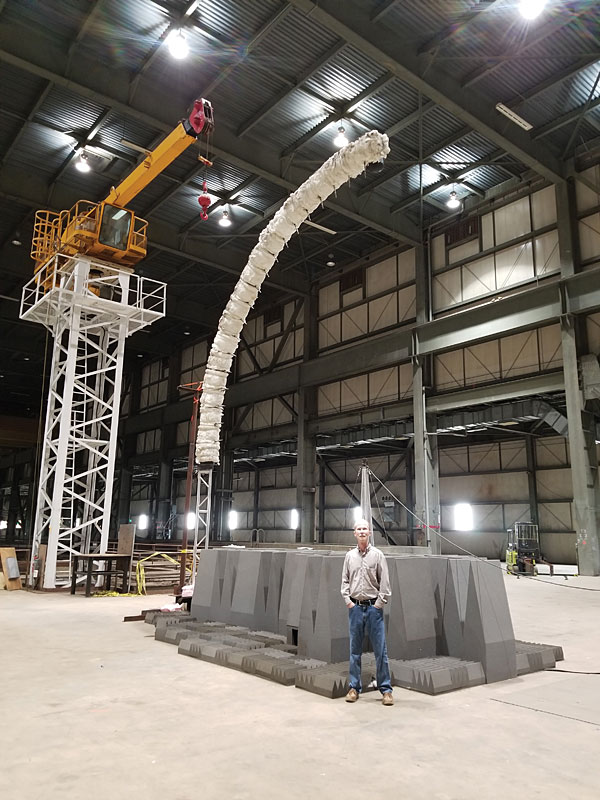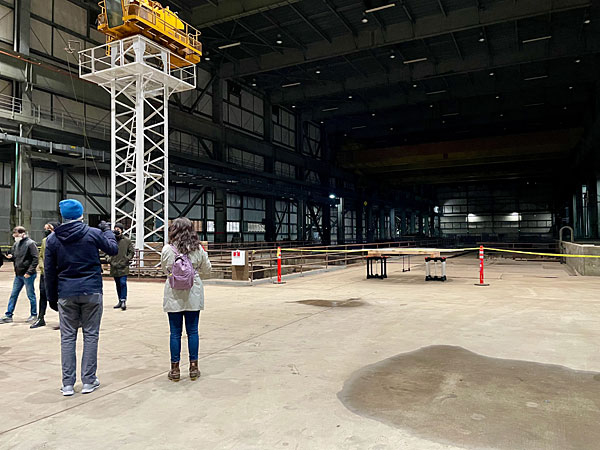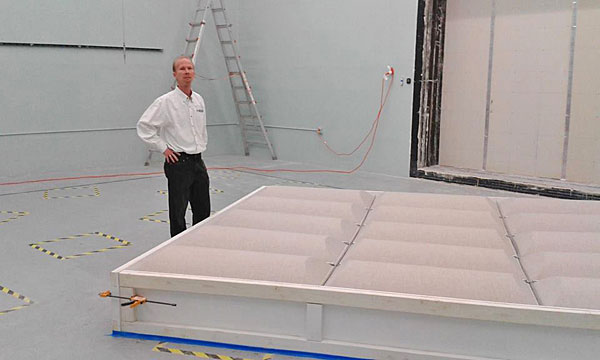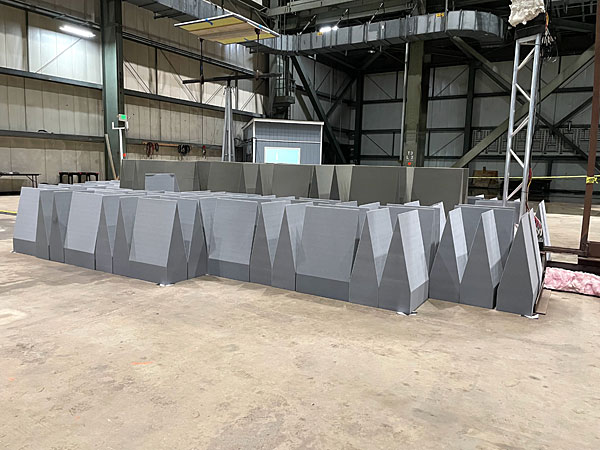| Columns Retired Columns & Blogs |
Thank you!
Other than the LS-360 turntable, did he mention which electronics [associated equipment] they prefer?
(Hidden joke disclaimer.)
Without hesitation, John responded, "It's going to reach an equilibrium point when the height of the water forces the water out of the 1" drain as fast as it is coming in from the 3" pipe."
"Bingo," replied Ron. "The pressure is going to change. It's the one thing that's not shown. As you increase the level of water, you'll increase the pressure, and the pressure will increase the flow rate. It will stabilize at the point where those all equal out.
"But here's the problem. Let's say you're lying back in this bathtub full of water, and you slowly but surely slip down into the water as you relax. Your nose gets closer and closer to the level of water, to the point where the water reaches your chin but your nose (ears) is in the air (and your ears are in the direct field). Then you keep sinking into the water until it has finally covered your nose and mouth. If you try to breathe (listen), you will drown regardless of how far down your nose is.
"The water is the reverberant field. The depth of your nose in the water is the equivalent of how far back you are in the reverberant field.
"This is what listening is. The reverberant field in a room is equivalent to the level of the water of the tub. Therefore, if you're in the back of the room, you are in the reverberant field, and you're hearing the same level as if you were under water."
"But that would mean you're beyond the critical distance in the room," objected John. "You're sitting a long way away."
"If you get beyond that point, you do not hear the speaker at all," Ron responded. "All you hear is the room."

Diffuser measurement and evaluation
NWAA Labs has been researching diffusion for the last five or six years and is developing a measurement standard for ASTM. Ron claims he can often tell whether a diffusion panel is effective or worthless just by looking at it.
"Because we look at diffusers as though they are a speaker without a voice-coil, we use the same measurement system for both products. At the very top of the microphone arc, behind the microphones and slightly off to the side, is a speaker. The speaker enables us to 'illuminate' the diffuser beneath it with sound waves so we can measure the first-order reflections and determine what's going on.
"We use diffusers in simulation programs exactly as we do a speaker. We can actually group them together and form clusters and then come up with a combined radiation pattern using convolvement techniques. We can create 360° plots to determine how soundwaves hit a spot on a wall and radiate off it."
When questioned about the efficacy of the various diffusion panels, some fancifully constructed, that are marketed to the audiophile community, Ron touted the work of Virginia-based Jim DeGrandis of Acoustics First Corporation. Ron has co-authored a paper with DeGrandis (and with Dr. Hassan Azad) on using laboratory measurements to improve acoustic simulations. Both are active in the ASA. Some of DeGrandis's papers, as well as many by Sauro, are linked to on the NWAA Labs homepage.
"DeGrandis has done some unbelievable research in the field of diffusion," Ron said. "He's come up with a computer program that allows him to simulate what happens to a design when he changes parameters. "We've done the same research with diffusion, where shape is again key. I'm sorry, but almost 90% of what's out there, theory-wise, is BS. For example, you can't use a block's length in a 'skyline-style' diffuser to determine the frequency range that it affects."
It goes without saying that the next question from both John's lips and mine concerned the efficacy of audiophile-approved devices. Which of them do work correctly?
"Let me put it this way," said Ron with circumspection. "Devices that are based on diffraction scramble the phase. When you scramble the phase, you lose localization. All the things you see, like one- or two-dimensional Quadratic Residue Diffusers, square blocks, and 'cityscape'-type diffusers, are diffractive devices. If you don't mind losing localization, you can use cityscape diffusers behind the recording or listening area, but they are extremely restricted in the frequencies they affect. Most are restricted to frequencies around about 4kHz and 16kHz. They do absolutely nothing below 4kHz.

"Believe it or not, if you want something that will actually move the sound where you want it to, some of the oldest devices out there are still the best. One of those is a polycylindrical or cylindrical unit. In my opinion, I would recommend sections of spheres. You take a sphere and just cut across the chord and stick it on the wall. That's probably your best bet for doing diffusion."
John raised the issue of specular reflections—the mirrorlike reflection of sound waves from a surface—and pointed out that when that reflection arrives at the listening position, the delay between the direct sound and the arrival of the reflection, which has taken a longer path, means that it won't be in phase.
"You've got to think about far field versus near field," Ron said.
John continued, "I always understood that specular reflections are a bad thing because at the listening position, you want to hear the direct sound. All the other energy in the room should be in the reverberant field, where it doesn't interfere with the imaging. Yet what you are saying is you want a specular reflection because the sound will arrive with the correct phase relationship."
Sauro responded that the reflection will arrive with intact phase and retain localization. He emphasized that if you use a cylindrical reflector, the reflection reaches the listener's ears from only one point on the cylinder. Because reflections from all the other points do not reach the ears, phase differential is inaudible. The amount of energy reaching the ears may be tiny compared to the total amount of sound reflected by the cylinder, but it maintains localization.
John asked whether a conventional Schroeder-type diffuser was restricted in its low-frequency performance.
"You have to look at the size of the diffuser," Ron replied. "Let's say it's 2' × 2'. If you're farther than 4' away, it does virtually no good because it functions as a point source with a single point of reflection. 2' × 2' looks like a single plane at 500Hz. That is the specular reflection. At 1000Hz, it's barely functional."
"Small room acoustics [footnote 9], which applies to almost all audiophile rooms, can be measured for reverberation," Norm noted. "You want linear reverberation times across as broad an audible spectrum as possible. For critical listening, we are trying to achieve an environment with reverberation times along the lines of about 0.25 to 0.4s from about 125Hz on up, and a little longer tail below 125Hz. If we have too short of reverberations time below 125Hz, it's uncomfortable, because our eyes are not making sense of what our ears hear."
Ron noted that Norm's A/V RoomService PolyFlex diffusion panels are among many that NWAA Labs has determined to work effectively in small listening environments.

For more information on absorption and diffusion, consult the papers hosted on the front page of Ron's website (footnote 10). For readers concerned with treating their own rooms, Ron recommends the first two papers, which discuss room acoustics and cost- effective ways to increase absorption.
Final thoughts and considerations
When I asked everyone to condense their knowledge about loudspeakers into a few simple bits of advice, John replied, "You have to take all the measurements and integrate them in your head. Or you could read the 15,000-word paper I presented at AES in 1997." (footnote 11)
Ron added, "You also have to keep in mind what the purpose of the speaker is. Audiophiles want a speaker that has the most even coverage possible at all frequencies."
Just when I thought we had a wrap, Norm returned to that little omnipresent monkey wrench: the room. "Audio reviewers have an incredibly difficult challenge because they are trying to correlate bench-test instrumentation data with subjective evaluations, which, to a huge extent, are predicated on their listening environment. The speaker, the distance, the size of the room, the reverberation times, and the resonances of the room all have a huge impact on the subjective perception of the sound. There's no way you can look at any single parameter and go, 'Oh, that's the way the speaker sounds.' Not in our lifetimes, most probably."
Ron replied, "In my segment of the industry, we say that the most important part of a speaker is the room. A good room can make a really bad speaker sound good, and a really bad room can make a great speaker sound horrible."
John smiled. "I wish I'd said that."
Ron affirmed that the reason he got into pure acoustics is that he figured out that if he could fix the room, he could fix most things. If he couldn't fix the room, he had very little chance of making a bad-sounding speaker sound good.
He then recommended an exercise that Stereophile founder J. Gordon Holt presented in the 1970s. "If you want to know how good your speaker will sound in your room, go where your speaker is and speak—one person to another person. That is the best that sound will ever be in your room because your voice is a point source coming directly from the mouth and the room has no effect on vocal production. How the room affects the sound after it leaves your mouth is the best your voice will ever sound in the room. When we approach large rooms, we always tell people, 'Just go to the stage and talk as loudly as you can to the people in the back row. If they can hear and understand you, that's the best the room will ever sound. Everything else will be downhill.'" Cheery thought.
Referencing theater acoustics, Ron said, "People assume that if you have a balcony or something out in front, that you can absorb the sound by putting absorption material on it. Nothing could be farther from the truth. The best the material can do is reduce the sound of that balcony face by about 10dB (footnote 12). That means if there is a time delay between when someone speaks or sings and when the sound returns to them, they will hear a direct echo that will cause them not to be able to sing well unless they tune the echo out. You can determine how well speakers "sing" just by singing into a microphone, hooking it up to a 20ms delay, and then listening back through headphones.
"Small-room acoustics are different. If you are slightly out of phase, you will change the timbre of the sound, the attack, the decay, the articulation, the low-level detail, the spatiality, and more. The sound will be fuzzy."

"If you're building a small room for audiophile reproduction, you'll want a speaker that doesn't have a lot of Q," Ron said. "You also have to set everything up for the spot where you'll sit because you can't set the room up so that everybody equally enjoys good sound. Pick one or two spots where you're going to listen and make certain your first-order reflections off the sidewalls and ceiling are covered. I would recommend a spherical or a cylindrical reflector at first-order reflection points on both sidewalls and on the ceiling. That's my personal preference because I like sound that is phase correct. I want to know where the localization is—where the singer is, and where the drummer is.
"Of course, I know recording engineers who prefer it the other way around. They prefer not having the localization and instead opt for an enveloping sound. That's their preference."
Norm suggested that there should be a standard for audio reviewers that includes good critical-listening environments in which room modes are distributed evenly and the sound of first-order reflections is lowered. Whether this is accomplished by absorption or diffusion is less critical than keeping reverberation times linear. If you've got a system that has a resonance here, a boost there, a cancellation here, and so on, you don't have a neutral reference.
According to both men, if you want to increase absorption using 1"- or 2"-thick fiberglass panels, you can double absorption by spacing multiple 2 × 2 panels on the wall rather than using a single sheet of 4 × 8. "Instead of having to buy three pieces of 4 × 8, you could buy one piece, cut it up into four 2 × 2 pieces, and get the same effect."
John said his ideal speaker setup involved having diffractive surfaces at the early reflection points and sitting close enough to ensure that direct output from the loudspeakers was at a higher level than the reverberant field. He described this as "sitting inside the critical distance." Norm described it as "reducing the specular reflection." John said he pays special attention to loudspeaker stereo-imaging capabilities and uses "mono pink noise" to ensure "a very narrow, stable image at all frequencies."
Ron may prefer direct sound with direct reflections, but both men consider it essential to understand the taste of the recording engineer because it determines how their recordings should sound. Which leads to the reason many of us devote so much time, energy, and capital to equipment and setup: We crave systems that faithfully reproduce the musical experience that recording engineers (and the artists they serve) want us to hear and feel.
Footnote 10: See nwaalabs.ipower.com/Papers%20and%20Publications.html.
Footnote 11: See stereophile.com/features/99/index.html, stereophile.com/features/100/index.html, and stereophile.com/features/103/index.html.
Footnote 12: Varney has attenuated ceiling reflections by 19.6dB using his FRP Ceiling Treatment.

Thank you!
Other than the LS-360 turntable, did he mention which electronics [associated equipment] they prefer?
(Hidden joke disclaimer.)

You captured it all perfectly. Best primer on the loudspeaker/room/listener interface I have ever read. Wow!

jason, i really enjoyed your very interesting report — nice to see such a facility outside of canada for a change :) but i'll bet you a beer that no structure constructed by mere mortals could withstand a 10 MT blast (nuclear or chemical) "on its roof". the IVY MIKE and CASTLE BRAVO tests were both of approximately such yields and a ten-ish-foot height of burst; they each resulted in craters roughly a mile and a quarter wide and two hundred feet deep. admittedly, they were both in wet sand, so a conservative reduction of the crater diameter and depth would be by a factor of two to allow for solid rock — any building on whose roof that firecracker went off wouldn't be in kansas anymore…